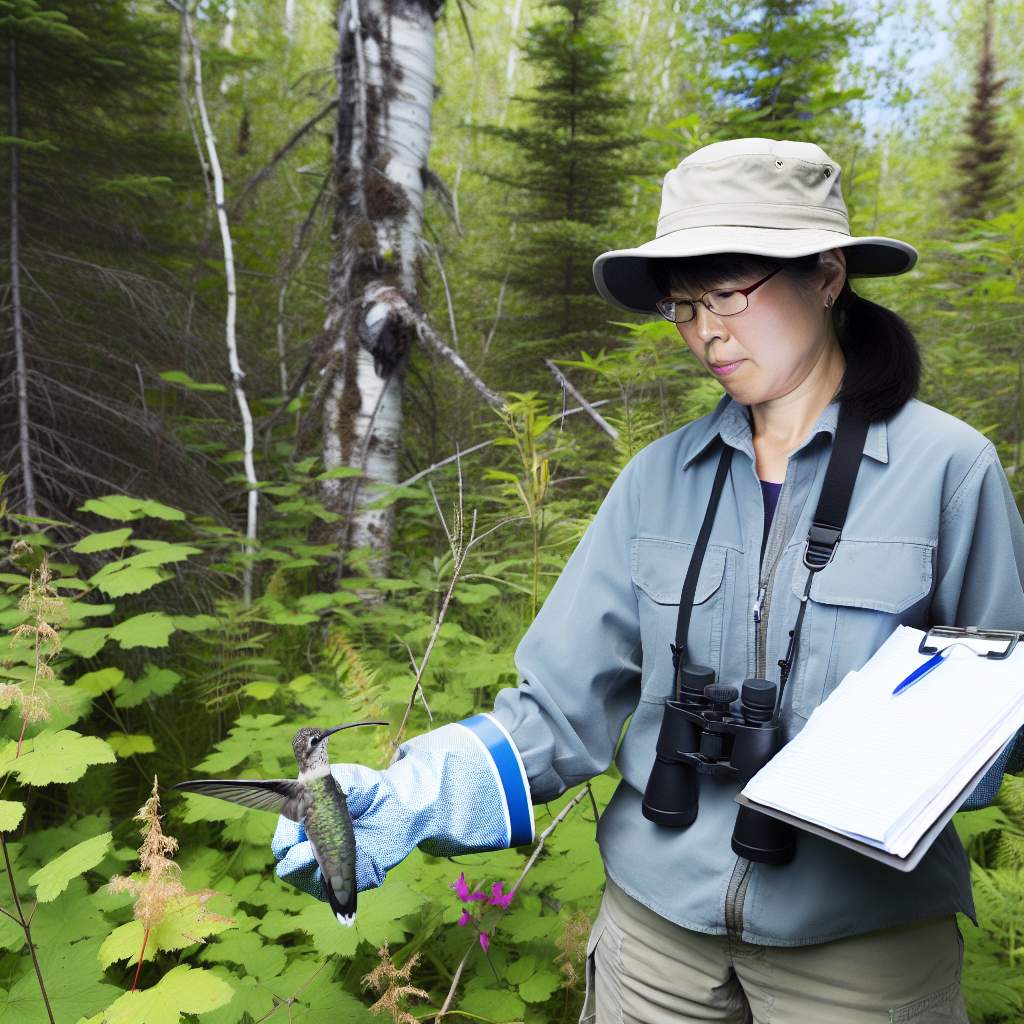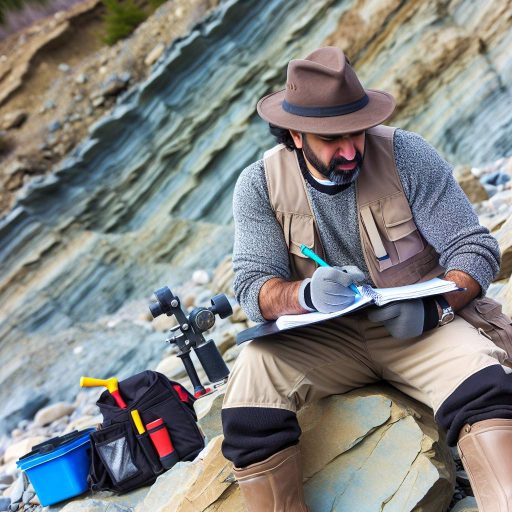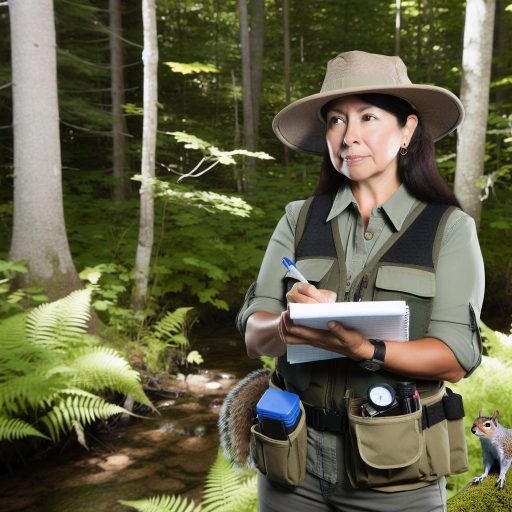Role of Wildlife Biologists in Species Preservation
Understanding Wildlife Biology
Wildlife biology is the study of animals in their natural habitats.
This science examines interactions within ecosystems.
It focuses on both species and their environments.
Wildlife biologists observe animal behavior and populations.
They also study plant communities that support these animals.
Importance of Conservation
Conservation is crucial for maintaining biodiversity.
Different species contribute to ecosystem health.
Healthy ecosystems provide services like clean air and water.
Protecting wildlife ensures that these ecosystems remain balanced.
Furthermore, conservation protects species from extinction.
Specific Roles of Wildlife Biologists
Wildlife biologists conduct field studies to gather data.
They monitor wildlife populations over time.
This data helps assess the health of species.
They also offer recommendations for habitat preservation.
Additionally, they conduct research to inform policy decisions.
Collaboration with Conservation Organizations
Wildlife biologists often partner with non-profits.
Such organizations include the World Wildlife Fund and local groups.
Through collaboration, they amplify their conservation efforts.
These partnerships focus on specific species and habitats.
Community Engagement and Education
Wildlife biologists engage with local communities.
They help raise awareness about local wildlife issues.
Education fosters a sense of stewardship among the public.
Workshops and talks promote wildlife conservation practices.
Techniques and Tools Used
Biologists utilize various techniques for their studies.
Telemetry helps track animal movements in the wild.
Unlock Your Career Potential
Visualize a clear path to success with our tailored Career Consulting service. Personalized insights in just 1-3 days.
Get StartedCamera traps capture images of wildlife without disturbance.
Genetic analysis provides insights into population health.
Field surveys assess habitat conditions and animal behaviors.
Overview of Species Preservation and Its Objectives
Definition of Species Preservation
Species preservation refers to efforts aimed at protecting endangered and threatened species.
These efforts ensure the survival of these species and their natural habitats.
In this context, wildlife biologists play a pivotal role.
Importance of Biodiversity
Biodiversity is essential for healthy ecosystems.
It supports ecological balance and resilience to environmental changes.
Moreover, it provides resources such as food, medicine, and materials.
Hence, species preservation directly contributes to maintaining biodiversity.
Objectives of Species Preservation
The primary aim is to prevent extinction of species.
Additionally, species preservation enhances ecosystem functions.
It also fosters genetic diversity, crucial for adaptability.
Furthermore, these efforts promote sustainable use of natural resources.
Conservation initiatives often focus on both in-situ and ex-situ methods.
In-Situ Conservation
In-situ conservation protects species in their natural habitats.
This method helps maintain ecological processes and interactions.
Protected areas, such as national parks, are prime examples.
Ex-Situ Conservation
Ex-situ conservation involves preserving species outside their natural habitats.
This approach includes botanical gardens and wildlife reserves.
It serves as a backup for species threatened with extinction.
Challenges in Species Preservation
Species face numerous challenges, including habitat loss.
Climate change also poses significant threats to biodiversity.
Moreover, pollution and overexploitation strain vulnerable populations.
Addressing these challenges requires coordinated efforts from various sectors.
Key Roles of Wildlife Biologists in Habitat Assessment and Monitoring
Understanding Habitat Requirements
Wildlife biologists assess the habitat needs of various species.
They collect data on the environmental conditions crucial for survival.
Moreover, they analyze the availability of food, shelter, and water.
This understanding informs conservation strategies and restoration efforts.
Conducting Field Surveys
Field surveys are essential for evaluating wildlife populations.
Biologists visit diverse ecosystems to gather data firsthand.
They monitor animal behavior and population dynamics over time.
Additionally, documenting changes in species distribution aids in monitoring trends.
Assessing Threats to Habitats
Wildlife biologists identify potential threats to natural habitats.
They analyze factors such as pollution, habitat destruction, and climate change.
Consequently, they develop strategies to mitigate these impacts.
Effective assessments help prioritize conservation actions.
Using Technology for Monitoring
Technology plays a vital role in habitat assessment and monitoring.
Biologists employ tools like GPS tracking and remote sensing.
These technologies enhance data collection and analysis efficiency.
Furthermore, they facilitate real-time monitoring of wildlife movements.
Collaborating with Conservation Organizations
Wildlife biologists work closely with various conservation groups.
Collaboration fosters knowledge sharing and resource pooling.
It also helps in implementing large-scale conservation projects.
Partnerships amplify the impact of preservation efforts.
Gain More Insights: Geologist Career Growth Opportunities in Canada
Methods Used by Wildlife Biologists in Population Studies
Field Surveys
Wildlife biologists frequently conduct field surveys to assess species populations.
They use both direct observation and counting techniques.
For instance, they may track animal movements using visual identification.
Furthermore, they often utilize camera traps to gather data.
Radio Telemetry
Radio telemetry serves as an essential method in wildlife studies.
This technique involves fitting animals with radio collars.
Biologists can then monitor the animals’ movements in real-time.
Moreover, this method provides insights into habitat use and behavior.
Genetic Analysis
Genetic analysis plays a crucial role in understanding population structure.
It helps biologists assess genetic diversity within and between populations.
Such information informs conservation strategies effectively.
Additionally, this approach aids in identifying mating patterns among species.
Satellite Tracking
Satellite tracking offers a high-tech solution for monitoring wildlife.
This method allows biologists to follow migratory patterns over vast distances.
It provides valuable data on habitat use and resource needs.
Consequently, this information helps in developing effective management plans.
Data Modeling
Data modeling enables biologists to predict future population trends.
They utilize statistical methods to analyze collected data.
This analysis allows them to forecast how populations may respond to various threats.
Additionally, it facilitates understanding the impact of environmental changes.
Uncover the Details: Key Responsibilities of an Epidemiologist
The Significance of Research and Data Collection in Species Management
Importance of Research
Wildlife biologists play a crucial role in species preservation through research.
Their investigations provide baseline data on species populations and habitats.
Research helps identify trends in wildlife health and ecosystem changes.
Moreover, it informs conservation strategies and policy-making decisions.
Data Collection Techniques
Wildlife biologists utilize various data collection methods.
Field surveys allow them to observe species in their natural habitats.
Remote sensing technologies offer insights into habitat conditions over time.
Additionally, genetic sampling helps assess genetic diversity within populations.
Analyzing Collected Data
Once data is collected, analyzing it becomes essential.
Biologists use statistical models to interpret population dynamics.
They identify factors affecting species survival, such as habitat loss.
This analysis is vital for developing effective conservation plans.
Informing Conservation Efforts
Research findings guide conservation programs and initiatives.
Wildlife biologists collaborate with stakeholders to implement strategies.
These strategies often include habitat restoration and protection measures.
Informed by data, conservation efforts become more targeted and efficient.
Continuous Monitoring
Monitoring species and habitats is an ongoing process.
Wildlife biologists regularly update their research to reflect changes.
This monitoring allows for timely interventions when threats arise.
Additionally, it ensures that conservation goals are met effectively.
You Might Also Like: Future Trends And Innovations In Physics Careers

Collaborative Efforts Between Wildlife Biologists and Governmental Organizations
Partnerships for Conservation
Wildlife biologists often collaborate with governmental organizations on conservation projects.
These partnerships aim to protect endangered species and their habitats.
Furthermore, they leverage resources and expertise to enhance preservation efforts.
Data Sharing and Research
Effective collaboration requires sharing vital data on species populations.
Wildlife biologists gather extensive field data for analysis.
Governmental agencies facilitate access to broader ecological data sets.
Combining these resources leads to more informed decisions in conservation.
Policy Development
Wildlife biologists contribute to the development of environmental policies.
Their expertise ensures that regulations are based on scientific evidence.
Additionally, they provide insights into the needs of various species.
This collaboration ultimately informs sustainable land-use planning.
Community Engagement
Engaging local communities is a crucial aspect of conservation efforts.
Wildlife biologists work alongside governmental organizations to raise awareness.
They conduct workshops and educational programs to inform the public.
Community involvement fosters stewardship for local wildlife.
Funding and Resources
Securing funding is essential for wildlife conservation initiatives.
Wildlife biologists often collaborate with government bodies to access grants.
These funds support research, habitat restoration, and monitoring efforts.
Moreover, pooling resources allows for larger, more impactful projects.
Discover More: Popular Workplaces for Ecologists in Canada
Case Studies Showcasing Successful Species Preservation Initiatives
California Condor Recovery Program
The California condor faced near extinction in the 1980s.
Wildlife biologists intervened by capturing the last remaining individuals.
They established a breeding program to ensure genetic diversity.
This effort led to the release of condors back into the wild.
As a result, condor populations have gradually increased.
Red Wolf Reintroduction
The red wolf is native to southeastern United States.
In the 1980s, wildlife biologists sought to revive its population.
They initiated a reintroduction project in North Carolina.
This project involved habitat protection and public education.
Through dedication, red wolves now roam the landscape once more.
Florida Panther Conservation
The Florida panther is a critically endangered species.
Wildlife biologists have focused on habitat preservation efforts.
They work to reduce vehicle collisions with panthers.
Additionally, they promote genetic diversity through management strategies.
Due to these efforts, the population has shown positive growth.
African Elephant Anti-Poaching Initiatives
Poaching poses a significant threat to African elephants.
Wildlife biologists collaborate with local communities to combat this issue.
They implement anti-poaching patrols and awareness campaigns.
Implementation of technology also aids in monitoring populations.
Consequently, these initiatives have helped stabilize elephant numbers.
Future Challenges and Innovations in the Field of Wildlife Biology
Emerging Threats to Wildlife
Wildlife biologists face numerous emerging threats to species preservation.
Habitat destruction continues to escalate due to urban development.
Climate change also poses significant risks to animal populations.
Pollution is affecting ecosystems and wildlife health on a global scale.
Additionally, invasive species compete with native wildlife for resources.
Technological Advances in Research
Innovations in technology are transforming wildlife biology practices.
GPS tracking enables precise monitoring of animal movements.
Camera traps provide valuable data on elusive species.
Drones offer new perspectives for studying habitats and populations.
Remote sensing technology aids in assessing habitat health.
Community Engagement and Education
Wildlife biologists increasingly engage local communities in conservation efforts.
They provide educational programs to raise awareness about biodiversity.
Partnerships with local organizations enhance support for wildlife initiatives.
Citizen science projects invite public participation in data collection.
This collaboration fosters a conservation ethic among community members.
Policy and Legislation Challenges
Effective conservation efforts require strong policy and legislation support.
Wildlife biologists advocate for laws protecting endangered species.
They also work to ensure sustainable land-use policies are enacted.
Government cooperation is crucial for successful wildlife management.
Challenges often arise from conflicting interests in land and resource use.
Future Directions in Wildlife Biology
The future of wildlife biology will require adaptive management strategies.
Integrating traditional knowledge with scientific research will prove beneficial.
Innovative funding mechanisms are necessary for long-term conservation.
Collaboration across disciplines enhances the effectiveness of wildlife research.
Ultimately, a holistic approach will address the complex challenges ahead.
Additional Resources
How to get a job in wildlife conservation or animal welfare
Wildlife Biology and Conservation | University of Guelph




